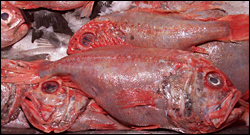|
Lobbyist says entire commercial fishery an ecological problem
New Zealand Herald
3rd June 2004
Orange Roughy
A major environmental lobby, Forest and Bird, today called for consumers to only buy fish from fisheries that do least harm to the environment -- but it said no species were relatively well managed.
In a study which divided 62 commercial fish species into three categories, green (best choice) amber (caution) and red (avoid), it said no fisheries had low habitat damage and low bycatch.
But in the next best ranking of the ecological sustainability of the marine fisheries, the top 12 ranking species included pilchard, blue moki, tarakihi, kina, blue mackerel, grey mullet and trevally.
This "amber" category included fisheries where there were concerns about the status of stocks, fishing methods, habitat damage, management, bycatch or lack of knowledge
But Forest and Bird conservation manager Kevin Hackwell said the worst 12 among the 42 in the "avoid" category -- overfished, poorly managed, with some high bycatches, or damage to marine habitats included some of the biggest commercial catches.
Orange roughy ranked worst of all, but other fisheries such as hoki, oreos, rig and snapper needed quota reductions and improved fishing techniques to do less environmental harm.
"The industry has a real challenge ahead of it," he said in a statement.
Consumers increasingly demanded that their food be sustainability produced, but until now had no way of knowing which fish were sustainably caught.
Mr Hackwell said that in the study no NZ fishery ranked green: "We are not able to show that any New Zealand fishery is well managed, with low habitat damage or bycatch and has good information on the status of stocks".
Around half the fisheries ranked amber, meaning that there were concerns about these fisheries, or there was simply no information on which to make a robust assessment.
"Half of New Zealand's fisheries are clearly not sustainable because they are overfished, poorly managed, have high bycatch, damage marine habitats and/or have poor information about the state of the fishery," he said.
The Forest and Bird assessment contradicted claims by the Ministry of Fisheries and the fishing industry that New Zealand's fisheries were sustainable and well managed, Mr Hackwell said.
He predicted overseas consumers would be shocked to hear claims that the NZ hoki and orange roughy were from fisheries close to collapse, or in which large numbers of marine mammals and seabirds were killed, or fragile deepwater coral habitats on seamounts were destroyed.
Mr Hackwell said the assessments of the 62 fisheries showed 16 were over-fished or there had been a substantial decline in stocks, 50 caused habitat damage, 23 killed significant numbers of seabirds, 28 killed a significant number of marine mammals, 56 caught too many non-target fish, and 60 caused adverse ecological effects.
Top
|
